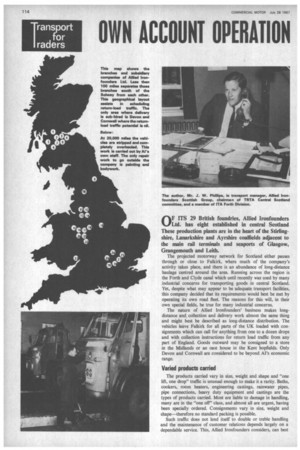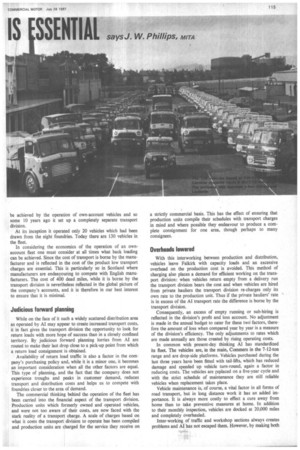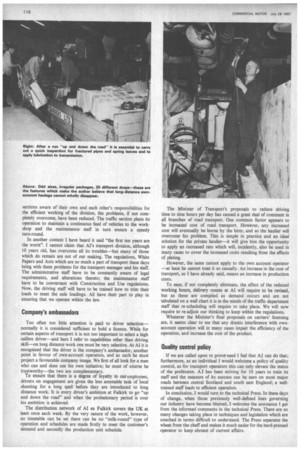OWN ACCOUNT OPERATION
Page 116

Page 117

Page 118

If you've noticed an error in this article please click here to report it so we can fix it.
riF ITS 29 British foundries, Allied Ironfounders ILlLtd. has eight established in central Scotland These production plants are in the heart of the Stirlingshire, Lanarkshire and Ayrshire coalfields adjacent to the main rail terminals and seaports of Glasgow, Grangemouth and Leith.
The projected motorway network for Scotland either passes through or close to Falkirk, where much of the company's activity takes place, and there is an abundance of long-distance haulage centred around the area. Running across the region is the Forth and Clyde canal which until recently was used by many industrial concerns for transporting goods in central Scotland. Yet, despite what may appear to be adequate transport facilities, this company decided that its requirements would best be met by operating its own road fleet. The reasons for this will, in their own special fields, be true for many industrial concerns.
The nature of Allied Ironfounders' business makes longdistance and collection and delivery work almost the same thing and might best be described as long-distance distribution. The vehicles leave Falkirk for all parts of the UK loaded with consignments which can call for anything from one to a dozen drops and with collection instructions for return load traffic from any part of England. Goods outward may be consigned to a store in the Midlands or an oast house in the Kent hopfieids. Only Devon and Cornwall are considered to be beyond AI's economic range.
Varied products carried
The products carried vary in size, weight and shape and "one lift, one drop" traffic is unusual enough to make it a rarity. Baths, cookers, room heaters, engineering castings, rainwater pipes, pipe connections, heavy duty equipment and castings are the types of products carried. Most are liable to damage in handling, many are in the "one off" class, and almost all are urgent, having been specially ordered. Consignments vary in size, weight and shape—therefore no standard packing is possible.
Such traffic does not lend itself to double or treble handling and the maintenance of customer relations depends largely on a dependable service. This, Allied Ironfounders considers, can best be achieved by the operation of own-account vehicles and so some 10 years ago it set up a completely separate transport division.
At its inception it operated only 20 vehicles which had been drawn from the eight foundries. Today there are 130 vehicles in the fleet.
In considering the economics of the operation of an ownaccount fleet one must consider at all times what back loading can be achieved. Since the cost of transport is borne by the manufacturer and is reflected in the cost of the product low transport charges are essential. This is particularly so in Scotland where manufacturers are endeavouring to compete with English manufacturers. The cost of 400 dead miles, while it is borne by the transport division is nevertheless reflected in the global picture of the company's accounts, and it is therefore in our best interest to ensure that it is minimal.
Judicious forward planning
While on the face of it such a widely scattered distribution area as operated by AT may appear to create increased transport costs, it in fact gives the transport division the opportunity to look for return loads with more hope of success than in a closely confined territory. By judicious forward planning lorries from Al are routed to make their last drop close to a pick-up point from which a return load consignment is obtained.
Availability of return load traffic is also a factor in the company's purchasing policy and, while it is a minor one, it becomes an important consideration when all the other factors are equal. This type of planning, and the fact that the company does not experience troughs and peaks in customer demand, reduces transport and distribution costs and helps us to compete with foundries closer to the area of demand.
The commercial thinking behind the operation of the fleet has been carried into the financial aspect of the transport division. Production units which formerly owned and operated vehicles, and were not too aware of their costs, are now faced with the stark reality of a transport charge. A scale of charges based on what it costs the transport division to operate has been compiled and production units are charged for the service they receive on a strictly commercial basis. This has the effect of ensuring that production units compile their schedules with transport charges in mind and where possible they endeavour to produce a complete consignment for one area, though perhaps to many consignees.
Overheads lowered
With this interworking between production and distribution, vehicles leave Falkirk with capacity loads and an excessive overhead on the production cost is avoided. This method of charging also places a demand for efficient working on the transport division: when vehicles return empty from a delivery run the transport division bears the cost and when vehicles are hired from private hauliers the transport division re-charges only its own rate to the production unit. Thus if the private hauliers' rate is in excess of the Al transport rate the difference is borne by the transport division.
Consequently, an excess of empty running or sub-hiring is reflected in the division's profit and loss account. No adjustment is made in the annual budget to cater for these two factors, therefore the amount of loss when compared year by year is a measure of the division's efficiency. The only adjustments to rates which are made annually are those created by rising operating costs.
In common with present-day thinking Al has standardized its fleet. The vehicles are, in the main, Commers in the 7-12-ton range and are drop-side platforms. Vehicles purchased during the last three years have been fitted with tail-lifts, which has reduced damage and speeded up vehicle turn-round, again a factor in reducing costs. The vehicles are replaced on a five-year cycle and with the strict schedule of maintenance they are still reliable vehicles when replacement takes place.
Vehicle maintenance is, of course, a vital factor in all forms of road transport, but in long distance work it has an added importance. It is always more costly to effect a cure away from home than to take preventive measures at home. In addition to their monthly inspection, vehicles are docked at 20,000 miles and completely overhauled.
Inter-working of traffic and workshop sections always creates problems and AT has not escaped them. However, by making both
sections aware of their own and each other's responsibilities for the efficient working of the division, the problems, if not completely overcome, have been reduced. The traffic section plans its operation to maintain a continuous feed of vehicles to the workshop and the maintenance staff in turn ensure a speedy turn-round.
In another context I have heard it said "the first ten years are the worst". I cannot claim that AI's transport division, although 10 years old, has overcome all its troubles—but many of those which do remain are not of our making. The regulations, White Papers and Acts which are so much a part of transport these days bring with them problems for the transport manager and his staff. The administrative staff have to be constantly aware of legal requirements, and alterations thereto; the maintenance staff have to be conversant with Construction and Use regulations. Now, the driving staff will have to be trained how to trim their loads to meet the axle loadings. All have their part to play in ensuring that we operate within the law.
Company's ambassadors
Too often too little attention is paid to driver selection— normally it is considered sufficient to hold a licence. While for certain aspects of transport it is not too important to select a high calibre driver—and here I refer to capabilities other than driving skill—on long distance work one must be very selective. At Alit is recognized that the driver is the company's ambassador, another point in favour of own-account operation, and as such he must project a favourable company image. We first of all look for a man who can and does use his own initiative; he must of course be trustworthy—the two are complementary.
To ensure that there is a degree of loyalty in our employees, drivers on engagement are given the less amenable task of local shunting for a long spell before they are introduced to long distance work. It is every driver's ambition at Falkirk to go "up and down the road" and when the probationary period is over his ambition is achieved.
The distribution network of Al ex Falkirk covers the UK at least once each week. By the very nature of the work, however, no timetable can be set there can be no "milk-round" type of operation and schedules are made firstly to meet the customer's demand and secondly the production unit schedule. The Minister of Transport's proposals to reduce driving time to nine hours per day has caused a great deal of comment in all branches of road transport. One common factor appears to be increased cost of road transport. However, any increased cost will eventually be borne by the hirer, and so the haulier will overcome his problem. This is simple in practice and an ideal solution for the private haulier—it will give him the opportunity to apply an increased rate which will, incidently, also be used in many cases to cover the increased costs resulting from the effects of plating.
However, the same cannot apply to the own account operator —at least he cannot treat it so casually. An increase in the cost of transport, as I have already said, means an increase in production costs.
To ease, if not completely eliminate, the effect of the reduced working hours, delivery routes at Al will require to be revised, but as these are compiled as demand occurs and are not tabulated on a wall chart it is in the minds of the traffic department staff that re-scheduling will require to take place. We will now require to re-adjust our thinking to keep within the regulations.
Whatever the Minister's final proposals on carriers' licensing are, it seems clear to me that any drastic interference with ownaccount operation will in many cases impair the efficiency of the operation, and increase the cost of the product.
Quality control policy
If we are called upon to prove need I feel that Al can do that; furthermore, as an individual I would welcome a policy of quality control, as for transport operators this can only elevate the status of the profession. Al has been striving for 10 years to train its staff and the measure of its success can be seen on most major roads between central Scotland and south east England; a welltrained staff leads to efficient operation.
In conclusion, I would turn to the technical Press. In these days of change, when those previously well-defined lines governing our industry have become blurred, I welcome the assistance I get from the informed comments in the technical Press. There are so many changes taking place in techniques and legislation which are couched in terms difficult to understand. The Press separates the wheat from the chaff and makes it much easier for the hard-pressed operator to keep abreast of current affairs.




































































































































































